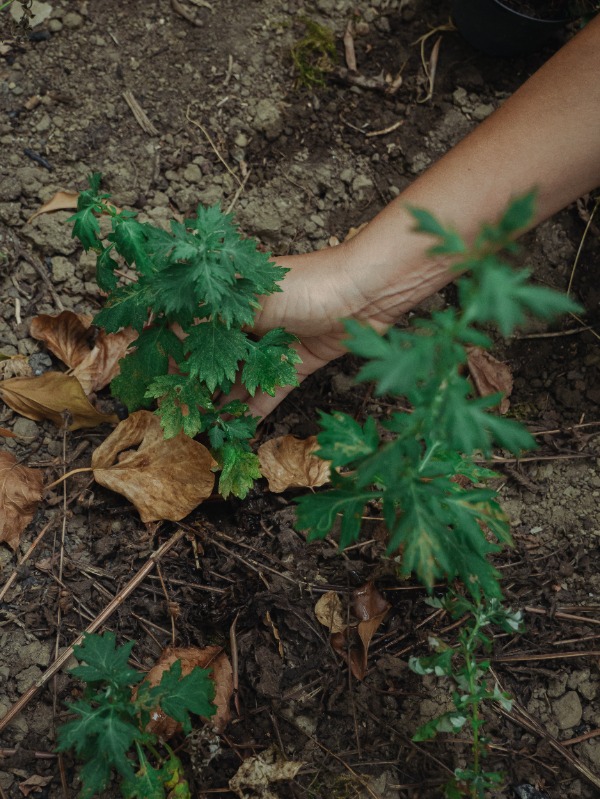A work of art is like a treasure chest whose power comes from the mystery it holds. Capturing its secrets requires an encounter between the work and the beholder—the spark: the wonder.
Summer 2024 saw Arianna Pace, Tommaso Mannucci (Monograff), and Ornella Cardillo exploring, investigating, and wandering through the village of Londa, with the aim of portraying the territory of the Montagna Fiorentina through their own gaze and practice.
Feet in the water, ears outstretched and gazing between sky heaven and earth, the artists invited the locals to a revealing encounter. The treasure chest opens and leaks bodies and intentions, desires and memories as well as small gifts – made of whispers and fleshy green leaves. In the three works of art, so different and viscerally linked, a sisterhood is revealed that is not universal but rather interpreted by each person and the enrichment of the encounter, in a fragment of joyful re-creation.
Curated by Martina Aiazzi Mancini
From September 6th to 8th the final program of A dimora, the second edition of the artist residency in the Florentine Mountains, took place.
In the summer of 2024, artists Arianna Pace, Monograff, and Ornella Cardillo resided in the Municipality of Londa, in the Florentine Mountains, with the aim of designing a work in dialogue with the town and the surrounding nature, as part of a project intended to highlight the relationship and practice of creation. The artist residency program seeks to create connections between people and the environment, stimulating reflections on physical spaces, ecosystem services, cultural heritage, and community economic models.
The works created during A dimora fully convey an image of the place made up of multitudes, old stories, new traditions, and an unbreakable bond with nature. The artworks created during this edition are permanent and become part of Londa’s landscape: from a mural in the town center to a shared garden nestled on the hillside to an illuminated sculpture on the lakeshore.
On the border between Tuscany and Emilia-Romagna regions in Italy, Londa and San Godenzo are the Florentine gateways to the Casentino Forests National Park, villages unique in the world for their rich heritage in terms of biodiversity, history and traditions.
Threatened and weakened by the lack of an exclusive vocation, the two municipalities suffer from a growing depopulation and ageing population.
Londa is a small town located in Valdisieve, a green area eastern of Florence, in Tuscany, Italy. Nestled in the picturesque Apennine Mountains, Londa has a rich history and heritage that dates back centuries.
The origins of Londa can be traced back to the Etruscan civilization, which thrived in the region between the 9th and 2nd centuries BCE. The Etruscans were skilled artisans and farmers, leaving behind traces of their presence through archaeological discoveries in the area.
The actual population is around 1800 people spread over 10 small districts all surrounded by forests, mountains and streams.
Nature is strongly intertwined with Londa’s community. Londa is one of the main accesses to the Parco Nazionale delle Foreste Casentinesi, a unique area of exceptional naturalistic value. Here is hosted Italy’s first Model Forest Association, a very important organization that characterized the development of the area in the last decades. The Model Forest is an innovative governance instrument for rural and forested landscapes.
To promote culture-led regeneration processes LAMA launched a three-year art residency named ‘A dimora’ (‘to plant’ in Italian).
The first cycle took place in the summer of 2023 and explored two main matters: the context of Londa and the relationship between human and natural environments.
The exploration of Londa was meant to acknowledge its rich historic and cultural legacy, but also to inquire about the existing cultural manifestations in the area and to map local opportunities for creativity enhancement.
The second edition took place during the months of June and July 2024.
The residency encouraged research processes and interaction with the community, creating shared experiences through artistic practices. The programme also facilitated access to the natural and cultural heritage and the social fabric of the territory by enabling encounters with local professionals, specialists, and experts, enriching conversation and research. Each artist was invited to present a project that can interpret, enhance, and interact with the most sensitive issues animating Londa, its inhabitants, and the territory itself, to return a strengthened and shared cultural identity of the place. The residency period included meetings, open studios, and other activities functional to each artist’s research, aiming to enhance the exchange of knowledge, skills, and reflections.
From the 16th to the 21st of June Londa has also hosted the first edition of Festival della Montagna Fiorentina (The Florentine Mountain Festival) featuring activities organized by local communities to attract curious travelers and mountain enthusiasts.
Arianna Pace

Along the shores of the lake amidst the unruly vegetation, a garden appeared, or rather flourished. The baroque hissing of the old man’s beard, the demure rustling of the nettle and the baritone solos of the cuckoopint: these are the sleeping voices waiting to be invoked by the digging, cutting and weaving of the artist’s hand. The space has become a work of art, as can be sensed from an iron gate whose curves recall those of the branches and stems within it – establishing a threshold that establishes a before and an after, an inside and an outside that voluptuously allows the garden to unfold.
Arianna Pace has involved the local community in a dialogue through the practice of giving, seeking a common relationship with nature that can become a legacy in which they can recognise themselves in every season and change. To create a garden is to make an idea manifest: how to coexist with the wild, uncultivated, and unknown soil, how to be a gardener of two communities, plant and human—how to make ourselves bloom gracefully through the landscape?
* G. D’Annunzio, Consolation, in Poema Paradisiaco, 1893
Tommaso Mannucci (Monograff)

There is a passageway in the heart of Londa unlike any other: a spot covered by high, dark wooden ceilings with red bricks and stone arches that connect the riverside area to the main square. Here is the artwork by Tommaso Mannucci (Monograff). The distinctive feature, as well as the chromatic balance of blue with white, is telling about what is outside, just a few steps away: the river, the wild animals, the sun and the forest, totemic elements that speak of the village’s undivided relationship with the nature that surrounds it.
With dreamlike gestures, the artist restores another landscape, no longer geographical but intimate, inviting the observer to search within himself for the flowing of his own river, to savour the rays of the sun and to walk through his own forest with its fauna.
Thanks to the continuous exchange with the community, and in particular with its youngest members, 50060 is enriched with interventions, with colours and gestures that highlight the importance of collaboration and doing together, of which the work is only the destination point.
Ornella Cardillo

Ornella Cardillo’s sculpture stands out in the lake’s green, mirrored in its waters like a tutelary deity, a spirit guarding and protecting the place. The work holds within itself a sacred fire that, when night comes, becomes light, warmth, and storytelling, letting the voices of Londa and those who inhabit it fall from its steel profiles.
Songs, anecdotes and wishes are enclosed in a timeless beacon, capable of showing itself in the darkness of the night and revealing what is invisible to the eye. Inspired by the town’s country’s ancient analogue lighting practices, the artist has created a sculptural element that has become a house of speech. And if the moon were to come into hiding, in the gloomy darkness of uncertainty, in the darkness without a destination – a light comes on in the twilight, inviting us to get closer and in the encounter, to get to know each other better.
Official Opening and Inauguration of Ornella Cardillo’s work
Friday, September 6th at 6:00 PM
Inauguration of Arianna Pace’s work
Saturday, September 7th at 11:00 AM
Inauguration of Tommaso Mannucci’s (Monograff) work
Sunday, September 8th at 4:00 PM



